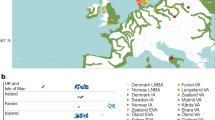Abstract
WILD populations of the tetraploid plant Lotus corniculatus L. (birds' foot trefoil) are polymorphic for the presence or absence of a cyanogenic glucoside. This character is genetically controlled1, the gene responsible for producing the glucoside being dominant over its allelomorph. Hydrocyanic acid is evolved on hydrolysis of the glucoside when the stems or leaves are injured. Corkill2 has shown that with Trifolium repens L. the change in the colour of sodium picrate paper from yellow to brick red is proportional to the amount of hydrocyanic acid produced and hence to the glucoside content of the plant. The plants are scored from 0 (no glucoside) to 6 by matching the colour-change in the picrate paper against a series of standards.
This is a preview of subscription content, access via your institution
Access options
Subscribe to this journal
Receive 51 print issues and online access
$199.00 per year
only $3.90 per issue
Buy this article
- Purchase on Springer Link
- Instant access to full article PDF
Prices may be subject to local taxes which are calculated during checkout
Similar content being viewed by others
References
Dawson, C. D. R., J. Genet., 42, 49 (1941).
Corkill, L., N.Z. J. Sci. Tech., 34, A, 1 (1952).
Daday, H., Heredity, 8, 61 (1954).
Author information
Authors and Affiliations
Rights and permissions
About this article
Cite this article
JONES, D. Selective Eating of the Acyanogenic Form of the Plant Lotus corniculatus L. by Various Animals. Nature 193, 1109–1110 (1962). https://doi.org/10.1038/1931109a0
Issue Date:
DOI: https://doi.org/10.1038/1931109a0
This article is cited by
-
Resequencing of global Lotus corniculatus accessions reveals population distribution and genetic loci, associated with cyanogenic glycosides accumulation and growth traits
BMC Biology (2023)
-
Principles and methods of bio detoxification of cyanide contaminants
Journal of Material Cycles and Waste Management (2020)
-
Chemical ecology in coupled human and natural systems: people, manioc, multitrophic interactions and global change
Chemoecology (2010)
-
Phenotypic Plasticity of Cyanogenesis in Lima Bean Phaseolus lunatus—Activity and Activation of β-Glucosidase
Journal of Chemical Ecology (2006)
-
Plant Cyanogenesis of Phaseolus lunatus and its Relevance for Herbivore–Plant Interaction: The Importance of Quantitative Data
Journal of Chemical Ecology (2005)
Comments
By submitting a comment you agree to abide by our Terms and Community Guidelines. If you find something abusive or that does not comply with our terms or guidelines please flag it as inappropriate.



